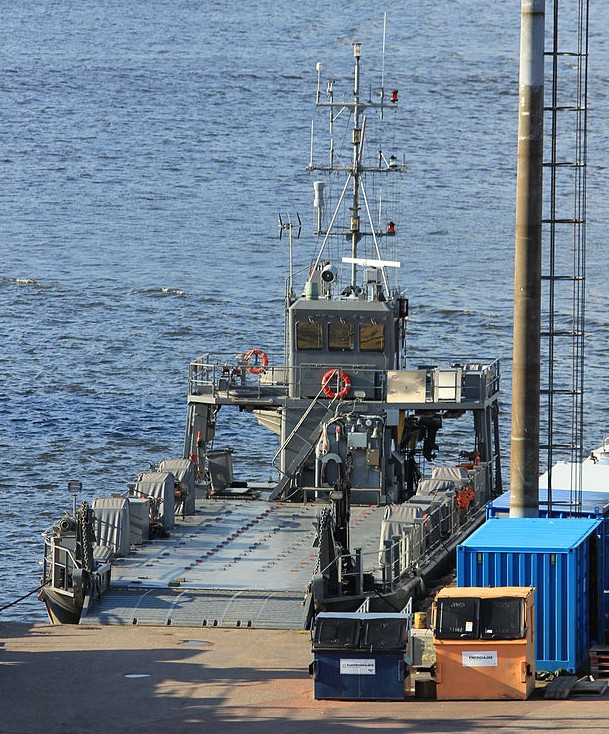
As the Russian News Agency ITAR-TASS recently published a picture gallery of 13 “Outstanding ships of the Russian Navy”, a twitter discussion took place about if the Finnish Navy could be presented in the same way. While waiting for the official feature, here comes a little pick focusing on classes instead of individual ships.
Hämeenmaa-class

The Hämenmaa-class consists of two vessel, which at a displacement of 1 300 t currently holds the distinction of being the largest ships in the navy. Both have been extensively upgraded roughly a decade ago, and features modern facilities, meaning they are as adapt at hunting pirates in the Indian Ocean as they are laying mines in the Gulf of Finland. Katanpää-class
The newest major ship class of the navy is in fact so new it is expected to reach operational readiness only next year. These multipurpose mine countermeasure vessels are equipped with modern equipment to be able to safely hunt down mines, or search the seabed for wrecks and similar. They are also the first Finnish naval vessels equipped with Voith Schneider propellers.
Pansio-class
The Pansio-class mine ferries may look ungainly with their big boxy hulls, but in reality they fulfill an important role in the navy, being able to handle not only large quantities of mines, but also of transporting general cargo in a roll-on/roll-off configuration.
Hamina-class
The Hamina-class fast attack crafts are for the navy what the F-18 Hornets are for the air force: they are fast, sleek, deadly… and expensive. The class represents the cutting edge of modern light surface combatants, equipped with some of the best sensors and armaments available.
U700-class

So new it is still waiting for its “proper” name, The U700-class, named “Jehu”, is the future workhorse for the Finnish marines, and a major boost compared to the current Jurmo-class. The new boats offer a higher top speed, ballistic protection, NBC-protection, and a remote weapon station. The marines will now be riding into battle in an APC, instead of in a truck like they used to.
G-boat

While the U700 may be the one with all the bells and whistles, few boats in the navy can match the thrill of the light G-boat speeding over the waves. The boat is used to transport small teams of soldiers to shore, with speed and maneuverability as its only defence. Thankfully, it has a lot of both, due to its single water jet and 170 kW/ (230 hp) engine.
Isku

The research and test vessel Isku is one of the less well-known vessels of the fleet. Operated by the Naval Research Institute, it is usually far from the headlines, but right at the forefront of current research.
Kampela 3

With all the grace of a car ferry, the Kampela is the logistics officer’s best friend, at least when an exercise requires large cargo to be shipped to one of the old island forts in the Gulf of Finland. The large deck can also be adapted with equipment to either lay or hunt for mines.
Louhi

The multipurpose vessel Louhi is unique in that it is owned by the Finnish Environment Institute (SYKE), but manned and operated by the navy. The main purpose of the vessel is to function as a response vessel in the case of oil spill accidents and other environmental disasters, but the daily trade of the vessel is centered around the laying of sea cables, functioning as a dive support ship, and performing underwater maintenance.


The “proper name” of the U-700 class is “Jehu”.
Indeed, I had missed that! Quite an interesting choice.
I’ve contacted people who have expirience with Buk systems. I was told that:
Buk missiles attack targets from above, if range exceeds 8 kilometers.
The missile engine runs only during first 8 km, so millile climbs above the target and uses potential energy to maintain high speed and maneuverability.
If plane was hit from below, it was less that 8 km to TELAR. If distance exceeded 8 km, it was not Buk missile.
Dear Corporal Frisk!
Please consider making this a permanent page on your blog. This is too awesome to be lost as one of many posts.
//James
Dmitry: Striking from below depends on the control engineering applied. The burn time is irrelevant, as the missile will not change guidance once the fuel is spent and it relies on inertia. Thus, a missile fired from below may very well strike from above or parallel.
Nice pics and stats corp!
Dimitry, you are trying to imply that it is impossible to hit a duck with a shotgun in flight. BUK is an exellent system and can score hits even in 20km height, if other parametres are favourable. Thus a great big boing in 10km in straight and level flight is no match!
It will be interresting to see how MTA 2020 will play out. I just hope they get sufficent numbers at last to deliver wat they are by law tasked to do.
IsoT